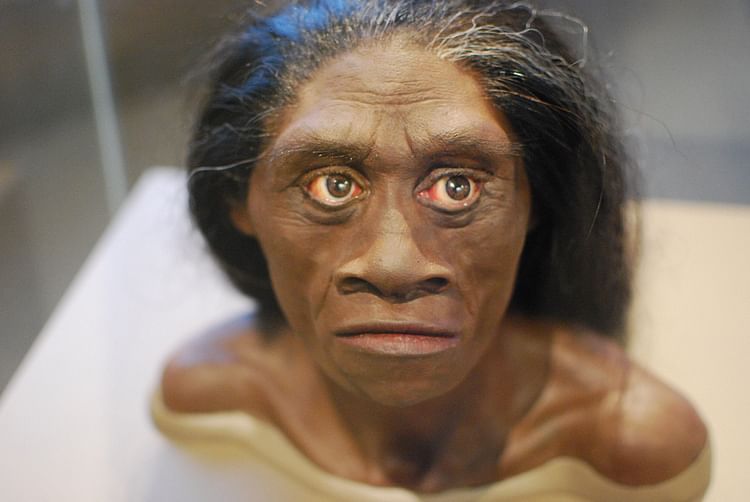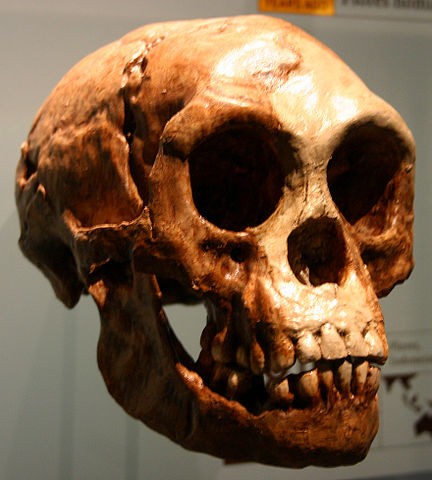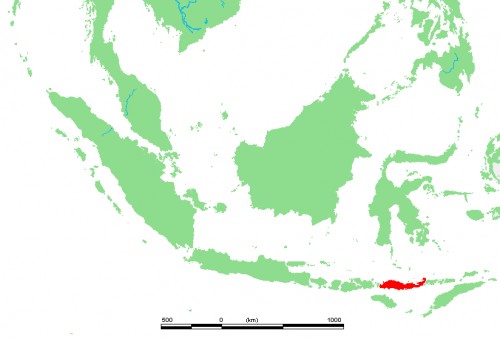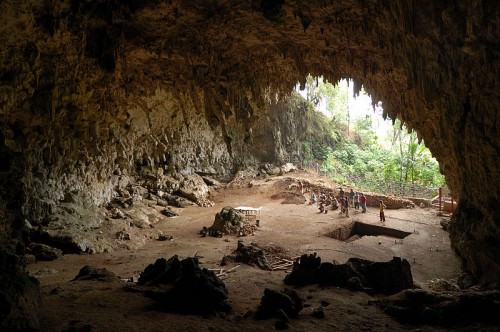Manyoshu › Homo floresiensis » Ancient origins
Articles and Definitions › Contents
- Manyoshu › Ancient History
- Homo floresiensis › Ancient History
Ancient civilizations › Historical and archaeological sites
Manyoshu › Ancient History
Definition and Origins

The Manyoshu or 'Collection of Ten Thousand Leaves' is an anthology of ancient Japanese poems compiled c. 759 CE during the Nara Period but including many earlier works. The most likely person to have assembled the collection is Otomo no Yakamochi, himself a prolific poet who included nearly 500 of his own works in the Manyoshu. The Manyoshu is regarded as a literary classic and high point of Japanese poetry.
OTOMO NO YAKAMOCHI
Many scholars consider the Manyoshu to have been compiled by the poet Otomo no Yakamochi (c. 718-785 CE). He certainly included plenty of his own works, some 479 or 10% of the collection. Yakamochi was born into an aristocratic family and his father was also a poet. When he was 30 years old, Yakamochi was made governor of the then minor and remote province of Etchu (modern Toyama Prefecture). This posting perhaps explains the poet's penchant for themes of separation and loneliness, unrequited love and descriptions of nature.
On an evening when the spring mistsTrail over the wide sea,And sad is the voice of the crane,I think of my far-off home.Otomo no Yakamochi (Henshall, 316)
Fortunately for Yakamochi, his posting was not permanent, and when he returned to the capital at Nara, he was given a role in the Ministry of Military Affairs. This did not stop his love of poetry as he was known to collect poems from the guards around the city. After 750 CE the poems stop, and Yakamochi died in 785 CE.
THE MANYOSHU ANTHOLOGY CONSISTS OF 4,496 POEMS ORGANISED INTO 20 BOOKS.
THE MANYOSHU
The Manyoshu collection contains poems which were all written in the Japanese of that time, ie using Chinese characters phonetically. The work consists of 4,496 poems organised into 20 books, the vast majority being in the tanka (aka waku ) style, that is each poem has precisely 31 syllables in five lines (5+7+5+7+7). 262 poems, in contrast, are written in the longer nagauta style, which can have up to 200 lines. There are also 62 sedoka poems (six-line poems of 38 syllables) and four poems written in Chinese. The poems come in three broad thematic categories; zoka (miscellaneous), somon (mutual inquiries or love poems), and banka (elegies). The poems cover a period of four centuries and it is likely they were intended to be sung.
Like Yakamochi's contributions, many of the poems deal with sadness and melancholy. Other famous names in the collection include Kakinomoto Hitomaro (active 685-705 CE) and Yamanoue Okura (660 - c. 733 CE). The former was only a low-ranked official at court, but he was regarded as the finest poet of the period. He has more than 80 of his poems in the anthology.Yamanoue Okura, another government official, but this time with experience of China (he may have come to Japan as a refugee from the Korean state of Baekje ), is represented by 70 poems. He was tutor to the crown prince (future Emperor Shomu), and his work is noted for its social element, notably on poverty. Other poets who contributed to the Manyoshu include less well-known poets, diplomats, princesses, emperors, soldiers, peasants, and many works are anonymous.
EXAMPLE POEMS
Countless are the mountainsin Yamato,but perfect isthe heavenly hill of Kagu:When I climb itand survey my realm,Over the wide plainthe smoke wreaths rise and rise,over the wide seathe gulls are on the wing;a beautiful land it is,Akitsushima,the Land of Yamato.Emperor Jomei (Keene, 96)
When, loosened from the winter's bonds,The spring appears,The birds that were silentCome out and sing,The flowers that were prisonedCome out and bloom;But the hills are so rank with treesWe cannot seek the flowers,And the flowers are so tangled with weedsWe cannot take them in our hands.But when on the autumn hill-sideWe see the foliage,We prize the yellow leaves,Taking them in our hands,We sigh over the green ones,Leaving them on the branches;And that is my only regret -For me, the autumn hills!Princess Nukata (Keene, 101)
Our great Sovereign, a goddess,Of her sacred willHas reared a towering palaceOn Yoshino's shore,Encircled by its rapids;And, climbing, she surveys the land.The overlapping mountains,Rising like green walls,Offer the blossoms with spring,As godly tributes to the Throne.The god of the Yu River, to provide the royal table.Holds the cormorant-fishingIn its upper shallows,And sinks the fishing-netsIn the lower stream.Thus, the mountains and the riverServe our Sovereign, one in will;It is truly the reign of a divinity.Kakinomoto Hitomaro (Keene, 103-4)
There I found you, poor man! -Outstretched on the beach,On this rough bed of stones,Amid the busy voices of the waves.If I but knew where was your home,I would go and tell;If your wife but knew,She would come to tend you.She, not knowing the way hither,Must wait, must ever wait,Restlessly hoping for your return -Your dear wife - alas!Kakinomoto Hitomaro (Keene, 111)
Will ever there beSomeone else who will restHer head on my armsAs once my beloved wifeMade her pillow there?Otomo no Tobito (Keene, 133)
Keeping glum silenceIn the role of a wise manIs still not as goodAs drinking one's own sakeAnd weeping drunken tears.Otomo no Tobito (Keene, 137)
…And in the cauldronA spider spins its web.With not a grain to cook,We moan like the “night-thrush.”Then, “to cut”, as the saying is,“The ends of what is already too short,”The village headman comes,With rod in hand, to our sleeping-place,Growling for his dues.Must it be so hopeless -The way of this world?Yamanoue Okura (Keene, 145)
If it were death to love,I should have died -And died againOne thousand times over.Otomo no Yakamochi (Keene, 151)
LEGACY
The poems of the Manyoshu inspired many later poets who copied the styles, imagery, and even phrases of the great masters.Some later poets wrote extensions of earlier works or their own 'replies' too. Even in structure the book has been influential, for, although it is not clear why the Manyoshu was divided into 20 books, it was a model followed by nearly all subsequent Japanese anthologies. The Manyoshu has been endlessly studied ever since its publication, not only regarding the meaning of the poems but also to create specialised studies on the biographical details, religious practices, and even the plants mentioned throughout this most important of Japanese anthologies.
This article was made possible with generous support from the Great Britain Sasakawa Foundation.
Homo floresiensis › Ancient History
Definition and Origins

Homo floresiensis, nicknamed 'hobbit' because it only stood about 1 meter tall, is an extinct species of fossil human that lived on the island of Flores, Indonesia during the Pleistocene. Floresiensis is still shrouded in a fair bit of mystery. First excavated at Liang Bua Cave in 2003 CE, these humans were originally thought to have lived between c. 74,000- c. 12,000 years ago, which would have made them the last surviving humans besides our own species of Homo sapiens. Recent evidence suggests, however, that these humans were actually quite a bit more ancient: their bones now come in at between around 100,000 and 60,000 years ago, and the tools found alongside them range between c. 190,000-c. 50,000 years old.There are a lot of things we do not know about Homo floresiensis as of yet, including the species' exact ancestry, which is still riddled with holes.
LOOKS & LIFESTYLE
These tiny people are by now known from over 100 bits and pieces that belonged to something between 9 and 14 individuals, all found at Liang Bua Cave. The type specimen (LB1) is a partially complete skeleton that is suggested to have been around 106 cm tall, while the rest of the individuals may have been a bit smaller still. Compared with other humans who lived around the same time, such as the Neanderthals (who come in at a rough average of 165 cm) and our own tall Homo sapiens, Floresiensis thus had a very different vantage point indeed.
Matching their small bodies, the only skull that has been found - belonging to the LB1 specimen - shows a brain size of around 426 cm3 (compared with roughly 1300 cm3 for Homo sapiens today). The skeletons of Homo floresiensis show a weird mosaic of features, some of which are more modern and others which are quite primitive; for instance, it had short legs in proportion to its arms, large feet (funnily matching its hobbit nickname), primitive wrist bones, but more relatively modern thumbs.

Homo Floresiensis Skull
Homo floresiensis survived by hunting and gathering on an island that showed clear signs of being quite isolated and happy doing its own evolutionary thing. Some small mammals had grown larger than their mainland siblings, whereas some of the larger ones show dwarfing, like the dwarfed Flores-version of the Stegodon - an elephant-like creature which seems to have been hunted by Floresiensis. Also present were komodo dragons, giant rats, and creepy, carnivorous birds like the massive 1.8-metre tall marabou stork. Although Homo floresiensis had fairly advanced stone tools and is thought to have known fire - which would have helped them deal with all of this stuff - the more symbolic or modern vibes that come through evidence of burials or personal ornamentation are completely absent.
UNEARTHING THEIR ORIGINS
Over the past decade, a whole cascade of theories has been proposed to explain who Homo floresiensis ' ancestors were.Initially, there were three main ones that popped up most frequently. The first was that Homo floresiensis evolved from Asian Homo erectus and then became dwarfed after arriving on the island (dwarfism occurring on isolated islands is not unheard of); the second was that they stemmed from an early species of Homo with roots in Africa, such as Homo habilis ; and thirdly, it was thought they may have been early Homo sapiens struck by some sort of disease or disorder. Frustratingly, these theories either could not properly explain all the hobbit's characteristics, or suffered from a lack of data available to push the balance in either one of these theories' favour.
HOMO FLORESIENSIS HAD SHORT LEGS IN PROPORTION TO ITS ARMS, LARGE FEET, PRIMITIVE WRIST BONES, BUT MORE RELATIVELY MODERN THUMBS.
Recent studies (see, for instance, Argue 2017) are shining some light into this murky muddle, though. New data suggests that Floresiensis seems to indeed be linked to an early Homo lineage rooted in Africa (more than 1,75 million years ago) and is either a sister species to Homo habilis specifically or sister to a group that spans at least Homo habilis, African and Asian Homo erectus, and Homo sapiens (and is at a similar evolutionary grade to Homo habilis ). Floresiensis ' ancestors must have left Africa in an, as of yet unknown, migration event, which may even have predated or almost coincided with the first steps of Homo erectus out of Africa, who are generally seen as the first Homo to have taken the plunge.
In this new scheme, Homo floresiensis is shown to not be closely related to Homo erectus or Homo sapiens specifically, and because of this distance to Homo sapiens the whole cry proposing that Floresiensis was a diseased form of Sapiens – which was already having significant trouble explaining the whole story – now seems to have landed out of the frying pan and into the fire.

Location of the Island of Flores, Indonesia
Despite this clarification, there is still a huge gap between these early Homo ( habilis ?) living in Africa over 1,75 million years ago, and Floresiensis skeletons being present on Flores in Indonesia between c. 100,000-c. 60,000 years ago (alongside tools ranging between around 190,000-c. 50,000 years old). The only possible stepping stone so far was unearthed in 2016 CE, at the site of Mata Menge, situated on Flores at a distance of 74 km from Liang Bua Cave where the Floresiensis specimens were discovered. A piece of jaw and some teeth found there have turned out to both be a whole lot older than the Floresiensisspecimens, coming in at around 700,000 years old, as well as astonishingly being about 20% smaller than the hobbits. These fragments are thus decent candidates for being the ancestors of Homo floresiensis, and if this is true, their lineage must have travelled from Africa at least once sometime between their early appearance there to landing on Flores by at least c. 700,000 years ago.
QUESTION MARKS
Besides the obvious gaps in their lineage, there are more loose ends to the hobbit's story. When their ancestors went on an adventure out of Africa at an unknown point in time, there was not only a long journey standing between them and the island of Flores; the island was inconveniently surrounded by enough water so that a simple swim would not have sufficed. It has been proposed that a tsunami or other sudden displacement of water may have swept the Floresiensis lineage from nearby places such as Sulawesi onto the green shores of Flores, and for now, this idea seems to hold a tentative consensus in explaining this bit of mystery. Furthermore, were these people who arrived on the island already quite tiny, or did they grow small in its isolation (which seems plausible, but how do the c. 20% smaller Mata Menge fossils fit into this equation?)?

Liang Bua Cave
On the island itself there are obviously huge gaps in the hobbits' timeline, too, and we really only know the big picture – it is hard to fill in many details regarding this species' lifestyle. We also do not know exactly when they disappeared, as the lack of evidence dated beyond c. 50,000 only demonstrates that as of yet we cannot trace their existence past that point, but not that they definitely did not live for a while longer still. Furthermore, even with a date of c. 50,000 in the back of our heads, that sets Floresiensis up for having a potentially overlapping time frame with both Homo sapiens and the Denisovans in south-east Asia.Recent discoveries have shown that early modern humans made it to the more westerly Indonesian island of Sumatra between c. 73,000 and c. 63,000 years ago, and a human presence has now also been uncovered in the north of Australia dating back to around 65,000 years ago, so it is not such a strange scenario to picture these early bands of humans traversing Indonesia and bumping into the hobbits. Without any direct evidence for this, though, it remains an open question whether or not they actually met.
It might take a good while to solve this Homo floresiensis -shaped puzzle to a higher degree. But when (or if) we do, their story has the potential to add a very interesting, perhaps even overturning, aspect to the clearly complex evolutionary path of Homo. After all, the work by Tolkien that matches these people's nickname has a sequel, too.
See other Related Contents ››
LICENSE:
Article based on information obtained from these sources:with permission from the Website Ancient History Encyclopedia
Content is available under License Creative Commons: Attribution-NonCommercial-ShareAlike 3.0 Unported. CC-BY-NC-SA License